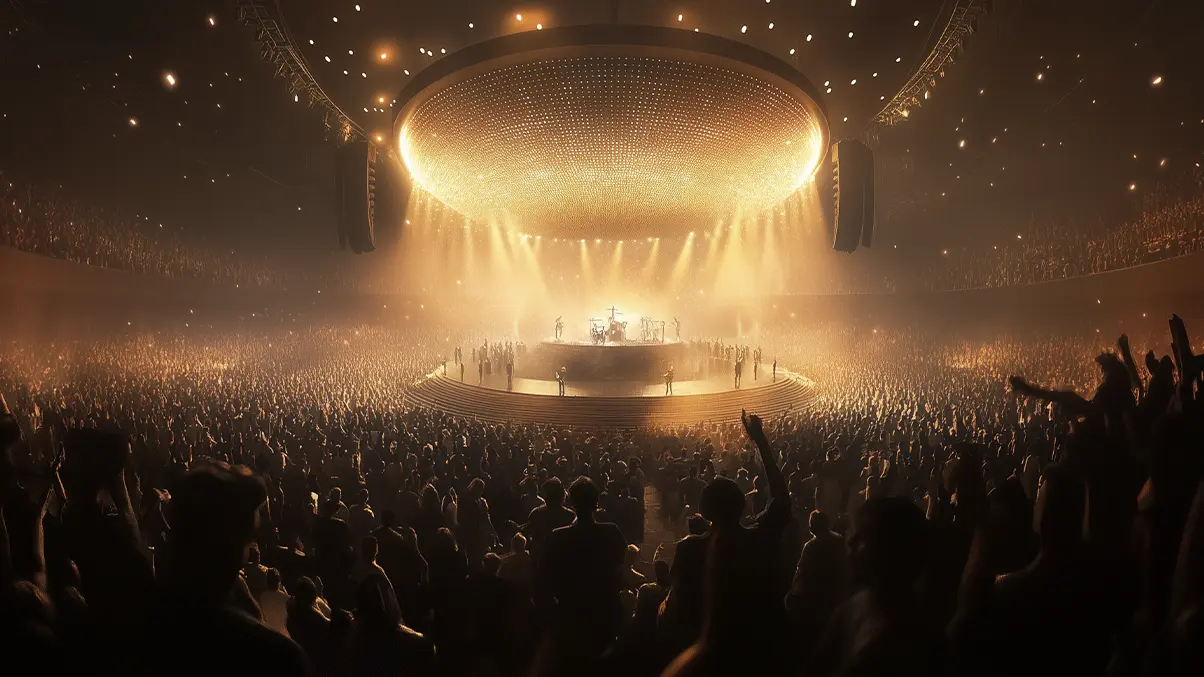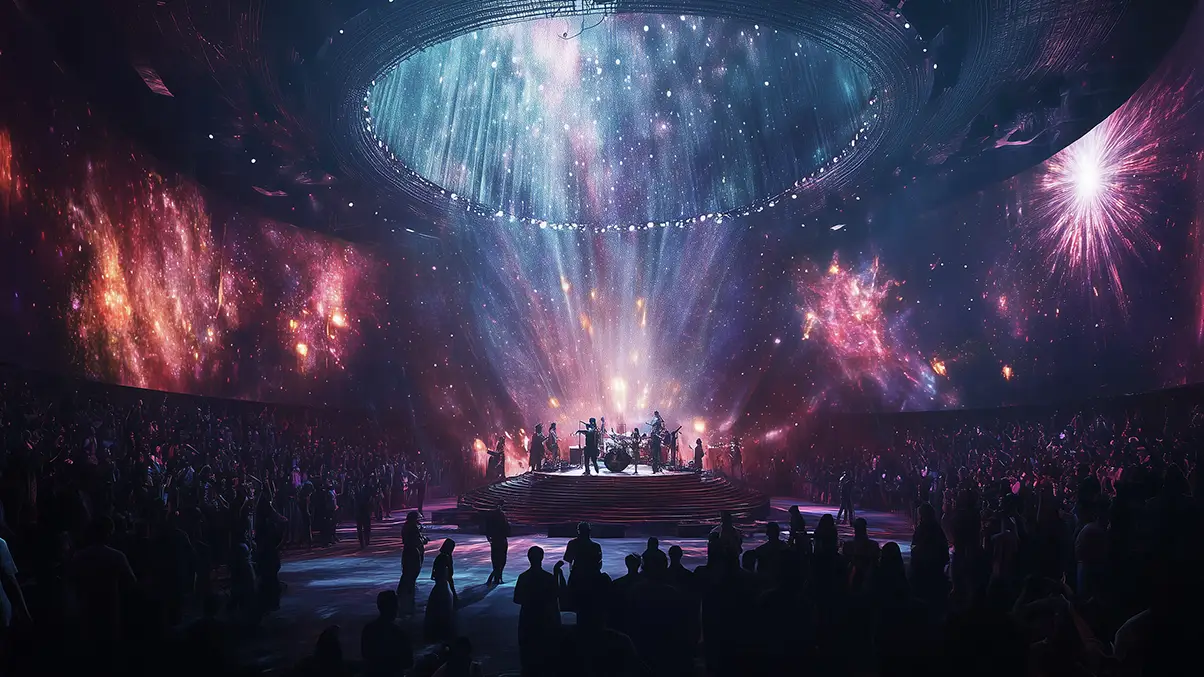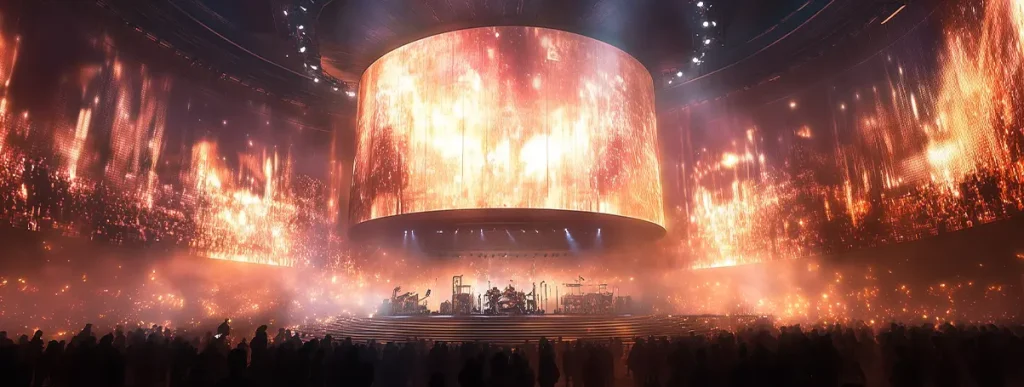Overview
From the ancient grandeur of Greek amphitheaters to the opulent halls of baroque opera houses, stage design has continually evolved to meet the needs of performers and audiences alike. This medium of expression is still evolving, leading to continued innovations in concert stage design. 3D stages and 360-degree concert stages are two of the most exciting new stage designs, revolutionizing how performances are experienced and offering new levels of immersion and interaction for audiences.
Understanding 360-degree concert stages

360-degree concert stages are designed to immerse the audience in the performance from every angle, ensuring that spectators can enjoy a panoramic view no matter where they are seated. The structure of these stages is typically circular, with tiered seating arranged around the center of the stage. This layout provides an unobstructed view and a sense of intimacy, as the performer is surrounded by the audience.
In addition to the physical design, 360-degree concert stages often incorporate advanced audio systems. These systems are engineered to provide spatial sound, ensuring that every audience member, regardless of their seat, hears the performance clearly and without distortion.
Moreover, these stages are often enhanced with dynamic technological elements such as moving platforms, complex audiovisual effects, and cutting-edge lighting designs. These innovations allow for a greater sense of engagement, where the environment can change in real-time to complement the performance.
One of the main advantages of 360-degree concert stages is their ability to foster a more intimate and interactive stage experience. Performers are no longer confined to one side of the stage, and the audience can experience the performance from all angles, creating a stronger connection between the two.
What are 3D concert stages and how do they work?
3D stages employ high-definition screens and projections to create a virtual concert stage that moves and evolves with the performance. The technology behind 3D concert stages allows for the creation of intricate digital environments, characters, and special effects that complement the music and storytelling.
These 3D backdrops are often designed by a team of animators and digital artists who work closely with the performers to ensure that the visual elements align with the performance’s narrative. The integration of 3D models and animations with live action creates a seamless, dynamic environment that enhances the audience’s experience. The backdrop can change throughout the performance, offering visual surprises and new layers of meaning, which would be impossible to achieve with traditional stage design.
Benefits and challenges of unconventional stage design
Unconventional stage designs like 360-degree concert stages and 3D concert stages offer significant advantages for performers and audiences. These innovative approaches to stagecraft create memorable, immersive concert experiences that captivate and engage viewers on a deeper level. By incorporating advanced technology, these stage designs also elevate the performance itself, giving artists new tools to express their creativity.

However, the use of such innovative stage designs also presents challenges. Constructing and setting up 360-degree concert stages and 3D stages requires specialized equipment, skilled technicians, and considerable financial investment. As a result, these stages are typically limited to larger venues or high-budget productions, which can restrict accessibility for some artists and venues.
Despite these challenges, the increasing availability of advanced stage design solutions is making these innovations more feasible for a broader range of events. Companies that provide budget-friendly, scalable options are beginning to emerge, and as the demand for innovative stage designs grows, the cost of production is likely to decrease.
Other innovations in stage design
While 360-degree concert stages and 3D stages are at the forefront of innovative stage design, there are many other cutting-edge technologies and techniques shaping the future of live entertainment. One of the most exciting developments is the integration of augmented reality (AR) into performances. Modern concerts often use AR elements to offer audiences an additional layer of visual content, which can be accessed through their smartphones or other devices.

Projection mapping is another innovation transforming stage design. Using advanced projection technology, stage designers can turn virtually any surface into an interactive, high-definition screen. This has proven especially effective for creating 3D stage backdrops that integrate seamlessly with the physical stage.
The integration of animatronics and robotics is also expanding the possibilities of stage design. Robotics can create moving set pieces, rotating platforms, and even robotic characters that interact with performers. This technology opens up new opportunities for dynamic, kinetic storytelling, making it possible for the stage environment itself to respond to the actions of the performers.
Finally, virtual concert stages represent a groundbreaking shift in how live performances can be experienced. By using virtual reality (VR) and other digital tools, artists can connect with fans around the world, creating interactive stage experiences that go beyond what can be achieved in physical venues.
FAQ
What is a 3D stage?
A 3D concert stage is a performance space that uses 3D-generated graphics as a virtual concert stage to enhance the live performance, often creating a fully immersive environment for the audience.
How do 3D concerts work?
3D concerts employ immersive technologies such as 3D projections, virtual reality (VR), or augmented reality (AR) to create an interactive stage experience for the audience. These performances can include holograms, special effects, and digital visual enhancements.
What is a normal concert stage?
A traditional concert stage typically features a rectangular design with a main performance area, side wings for equipment, and a roof structure for mounting audiovisual systems. The audience views the performance from a fixed, forward-facing angle.
How long is a concert stage?
A medium-sized concert stage, capable of supporting 7-10 performers, typically measures around 20 feet by 24 feet (480 sq. ft.) or 6 meters by 7.5 meters (45 sq. meters).
What are the different types of stages?
There are various traditional stage types, including proscenium stages with an architectural frame, thrust stages where the audience surrounds the performance on three sides, and arena stages where performers are positioned in the center of the audience. Other types include end stages, which resemble proscenium stages but lack an arch.



